Embracing Equity and Inclusion to Bolster Georgia’s Economy
By Wesley Tharpe, Research Director and Alex Camardelle, Senior Policy Analyst
Georgia is widely known as one of the fastest-growing states in the country and is projected to remain so for the foreseeable future. But fewer people are aware of the striking diversity of Georgia’s population, both today and expected in the future. People of color are projected to become a majority of Georgians by 2030, and a rising number of immigrants are calling Georgia home. Georgia gains enormous value and vibrancy from its current and future diversity, but structural barriers too often stand in the way of people of color and immigrants striving to get ahead. Unless Georgia lawmakers embrace the state’s diverse future and work to ensure that all people are offered opportunities to thrive, the state’s economy and communities will fall short of their potential.
This Georgia Budget and Policy Institute report presents new estimates that show how the state’s population is predicted to diversify over the next 30 years and a case for why clearing obstacles that hinder immigrants and people of color is the best economic approach for Georgia policymakers. The state’s own projections show the Peach State added nearly 4 million residents the past three decades and could add another 4 million over the next three. Based on these numbers and other state and national data, GBPI estimates:
- People of color could account for about 85 percent of new Georgians over the next three decades or about 3.2 million of a projected 3.8 million new state residents. Georgia is estimated to add 1.2 million Latinos, 826,000 Asians, 751,000 African Americans and 421,000 people who categorize as Other between 2020 and 2050, alongside 582,000 new white residents.
- Georgia is poised to continue serving as a popular destination for newcomers born outside the United States. The state’s immigrant population may increase by 671,000 people over the next 30 years, rising to an estimated 1.8 million in 2050 from 1.1 million in 2020. Immigrants could account for about one in eight Georgia residents by 2050, up from one in 10 today and one in 37 in 1990.
As one of the most diverse states in the country, Georgia’s prosperity requires all people get equal footing to participate in the economy. Yet Georgia’s history of slavery, Jim Crow laws, mass incarceration, exclusion of African-Americans from home loans and jobs combined with decades of low investment in high-minority schools casts a shadow of economic distress. Current and historic roadblocks separate too many families from opportunity and are counterproductive to economic growth. The missed opportunity grows larger after accounting for hostile policies toward people born outside the U.S. To reverse course, state and local policies that embrace diversity and eliminate disparities, such as strengthening finances for families of color and improving access to quality and affordable education, are crucial to build a thriving Georgia with an inclusive economy.
“Equity — long a matter of social justice and morality — is now also an economic imperative. The nation can only achieve and sustain growth and prosperity by integrating all into the economy, including those who have too often been left behind.”
– Angela Glover Blackwell, PolicyLink
Georgia’s Population Projected to Grow More Diverse
Georgia is one of the most diverse and fastest-growing states in the country. The state added nearly 4 million people from 1990 to 2017, an increase of 61 percent—the eighth highest growth rate among the states.[1] The state’s demographic makeup also shifted dramatically during that timeframe. White Georgians accounted for about 55 percent of the state’s population in 2015, down from 70 percent in 1990.[2] Today only Hawaii, New Mexico, California and Texas are home to more people of color as a share of the population than Georgia.[3]
These trends appear likely to continue. Georgia will swell from the nation’s eighth-most populous state today to sixth by 2040, according to one estimate.[4] Georgia’s overall population will reach an estimated 14.7 million by 2050, up from a projected 10.9 million in 2020—an increase of about 3.8 million people.[5]
African-Americans, Latinos, Asians and people who categorize as ‘Other’, which in Georgia most commonly equates to individuals and families who identify as multiracial, are likely to create the vast majority of that growth. People of color could account for about 85 percent of new Georgia residents over the next 30 years, according to GBPI analysis of state population projections.[6]
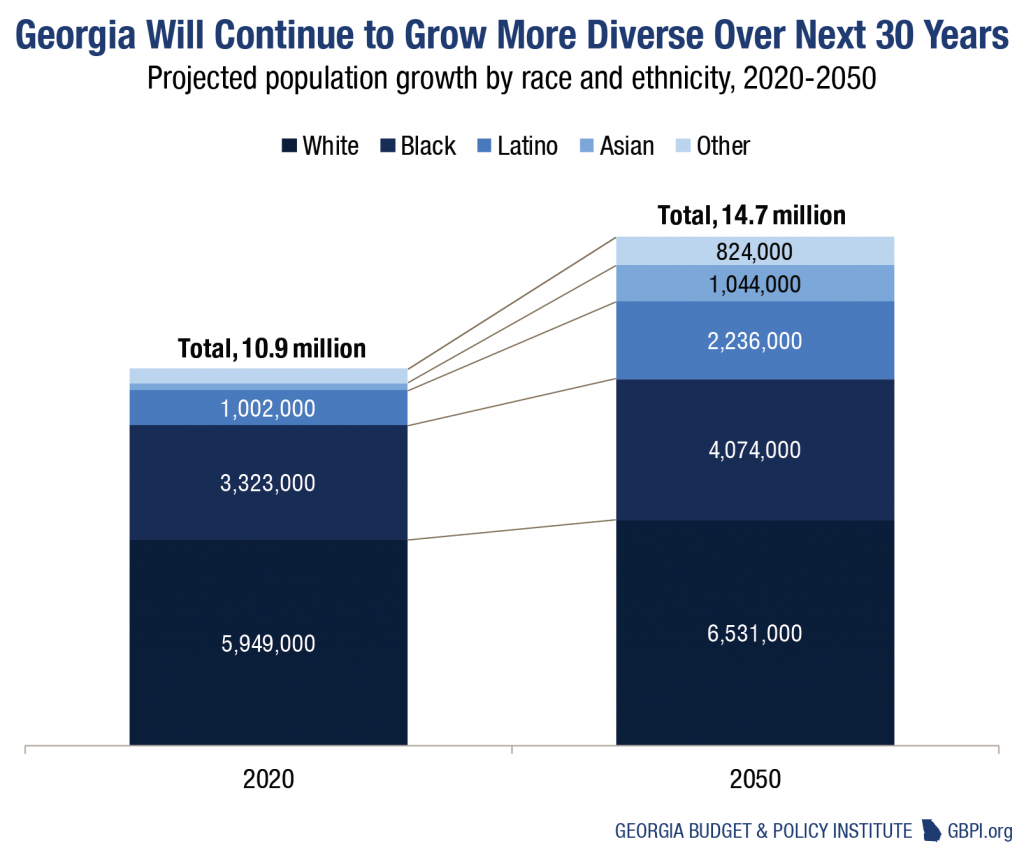
White Georgians are expected to remain the single largest racial or ethnic group in 2050, however their share of the state’s population will decline to an estimated 44 percent in 2050 from a projected 55 percent in 2020. Georgia will add about 582,000 white residents over the next 30 years, according to GBPI estimates.
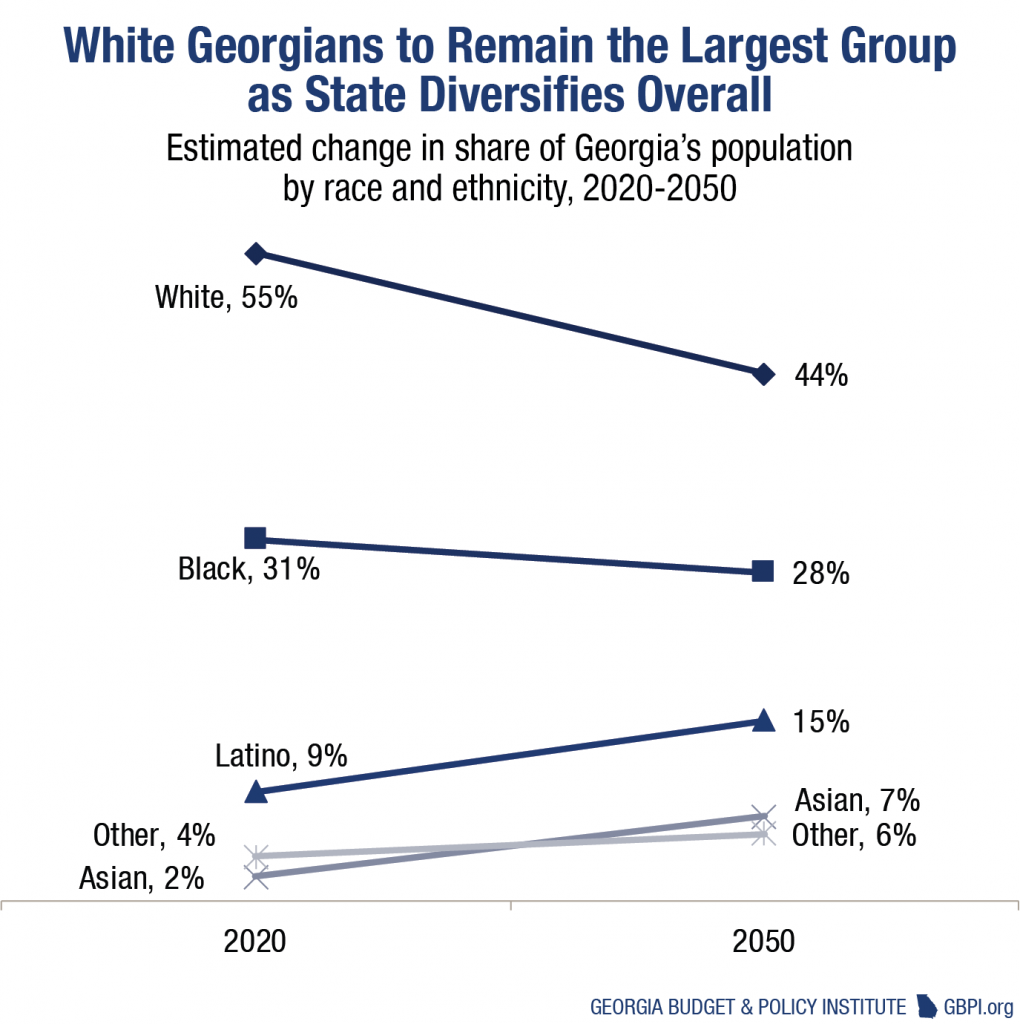
Black people have long comprised the second-largest group of Georgians. About a third of the state’s population was black immediately after the Revolutionary War, rising to nearly half by the late 1800s.[7] In 2017, nearly 32 percent of Georgians were black, the third-largest share among the states behind Louisiana’s 32.5 percent and Mississippi’s 38 percent.[8] Georgia could add about 751,000 black residents between 2020 and 2050. Yet, the share of black Georgians might slightly decline, due to rapid growth among Latino, Asian and multiracial people.
Georgia could add an additional 1.2 million Latinos, 826,000 Asians and 421,000 people categorized as Other over the next 30 years, according to GBPI estimates. By 2050, these three groups will account for about 28 percent of Georgia’s population, up from 15 percent in 2020. A more precise breakdown is shown in the chart.
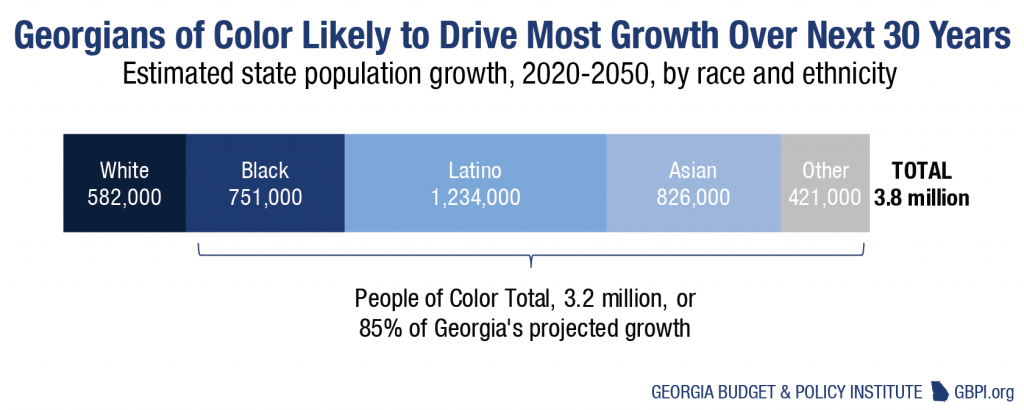
Immigrants Likely to Play Key Role in Georgia’s Growth
Georgia today is home to more than 1 million people born outside the U.S., up from only about 173,000 in 1990. About one out of every 10 Georgians today was born in another country, versus one in every 37 in 1990.[9] The Peach State’s growing community of foreign-born Georgians is a considerable asset, providing a powerful boost to Georgia’s economy, workforce and finances.[10] Immigrants are just 10 percent of Georgia’s population, yet they own an estimated 31 percent of the state’s main street businesses, for example.[11]
The state’s immigrant population could rise to 1.8 million by 2050 according the GBPI analysis of U.S. Census projections, a jump of 671,000 people from 2020’s projected 1.1 million. By 2050, immigrants could account for about one in eight Georgia residents.[12]
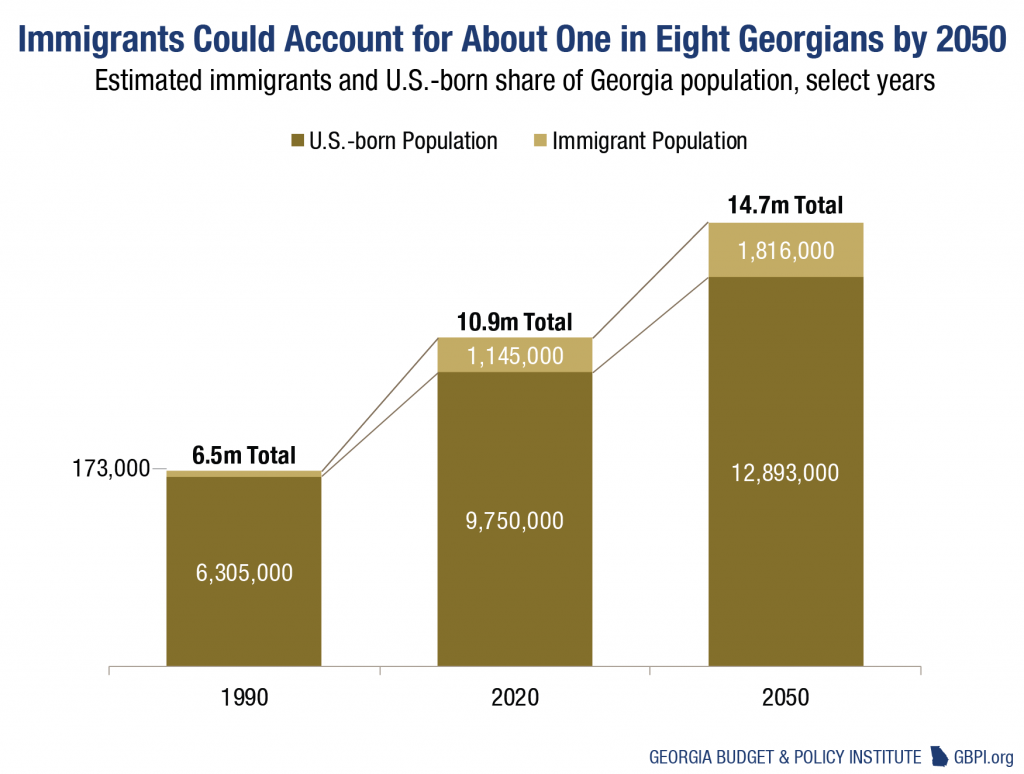
Georgia’s Economy Undervalues Talent of Diverse Population
Georgia can boast a remarkable economic story over recent decades. The state enjoys a reputation as the economic engine of the South and a lead state for business growth. That attracts new families and businesses to adopt Georgia as their home. Employment opportunities and productivity bolster the state’s Gross Domestic Product (GDP), which more than doubled the last 20 years to about $550 billion from $268 billion.[13]
But while the rewards of a growing state economy are often assumed to be broad-based, the direct benefits bypass many Georgians. Economic growth too often leaves people of color and immigrants behind. Reasons for that include current and historic structural barriers such as Georgia’s history of slavery and structural racism in the criminal justice system.[14] Hostile policies for newcomers, such as harsh voluntary immigration enforcement, also play a part.[15] Georgians of color, in particular African-Americans and Latinos, trail their counterparts on several important measures of social and economic well-being, including income, employment, wages and poverty.
Incomes Typically Lower for Families of Color
Persistent gaps among Georgians are perhaps best measured by variances in median household income. In 2017, the typical white family in Georgia brought home about $21,000 more than the typical black family and nearly $18,000 more than the typical Latino family. Asian families in Georgia fared better with a typical $77,000 income, though national research suggests that state-level data often hides sizable disparities in well-being among various Asian communities.[16]
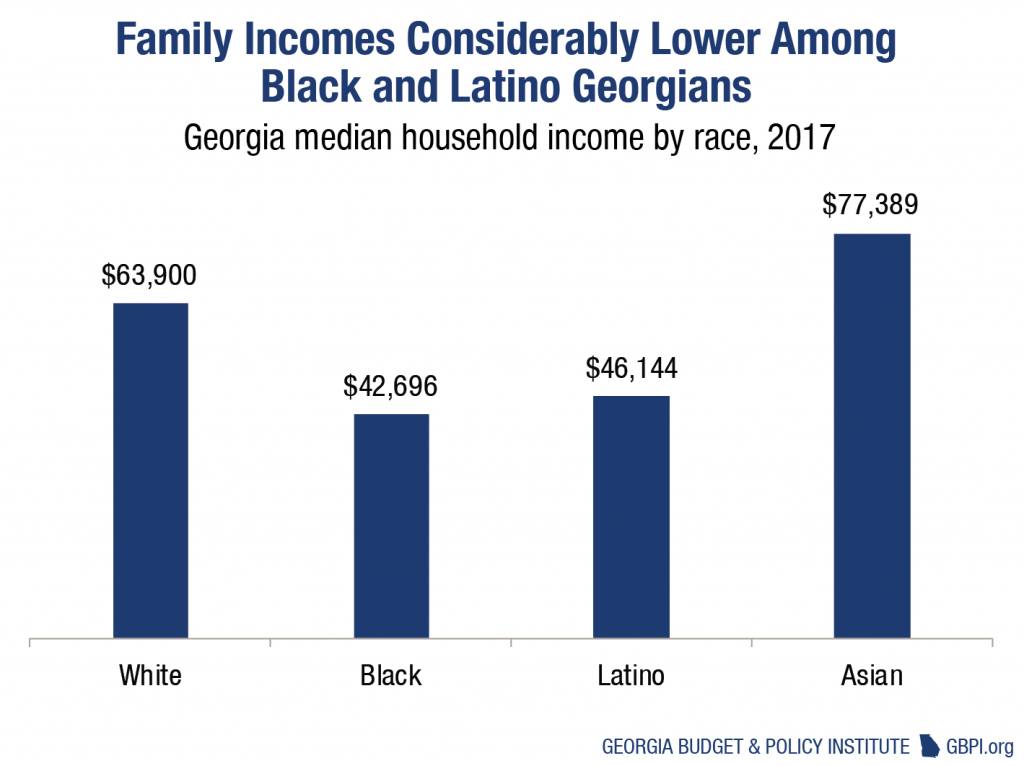
If the income of Georgians of color equaled that of white Georgians, the total earnings for everyone could improve and the whole economy would grow through greater purchasing power. Families with more money to spend translates to additional dollars going into cash registers at local shops and restaurants, more money to buy homes and cars and more savings to put aside at local financial institutions.
Increasing the stability of families also puts the next generation of Georgians on stronger footing. One in four children in Georgia lives in poverty. Children born to families at the bottom of the income ladder have just a 41 percent chance of reaching the middle class, and only an 8 percent chance of reaching the top. Racial inequities in income due to low-wage work contribute to the strain on household budgets, compounding the challenges faced by children born at the lowest end of the economic spectrum.
Employment Gaps Persist
Georgia is adding jobs more quickly than most other states, but that job growth isn’t closing the unemployment gap for people of color. Georgia’s unemployment rate stood at 4.4 percent in 2006, a year before the recession started in December 2007. More than a decade later, Georgia’s statewide unemployment rate returned to pre-recession levels.[17] Still, the statewide number masks significant racial disparities.
Immediately following the recession, 16.4 percent of black Georgians remained unemployed, compared to 7.6 percent for white Georgians. In 2017, those rates dropped dramatically, with black unemployment at 8 percent and white unemployment at 3 percent. Although state-level unemployment rates fell by half for both groups, the gap persists. Tellingly, the unemployment rate among white Georgians peaked at 7.7 percent in 2011, whereas the jobless rate among black Georgians had not fallen to that same level until 2017.
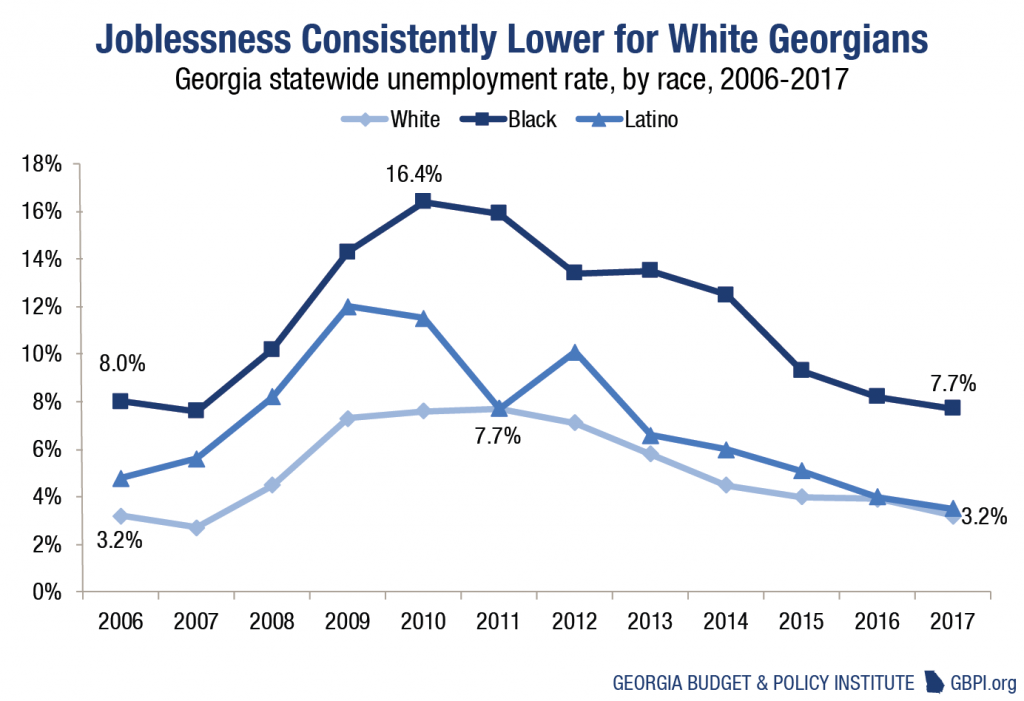
People of color continue to face structural racism, outright discrimination and subconscious bias that contribute to higher unemployment. Even when education and skills are equal, white job applicants are more likely to secure job interviews than black applicants, research shows.[18] People of color are also more likely to get slapped with criminal records for minor or nonviolent infractions, have lower levels of educational attainment and lack access to quality job centers.
Wages Flat for Many Workers and Lower for People of Color Overall
Even for people of color with jobs, the economic challenges persist. Although Georgia is home to healthy job growth, evidence indicates that most new jobs are concentrated in industries that pay wages that leave workers and families below the federal poverty guideline.[19] Partly as a result, wages for many Georgia workers remained flat over the past few years and long-standing wage gaps persist. Wage stagnation is “easily the most pressing common issue for an increasingly diverse working class,” according to the Economic Policy Institute.[20]
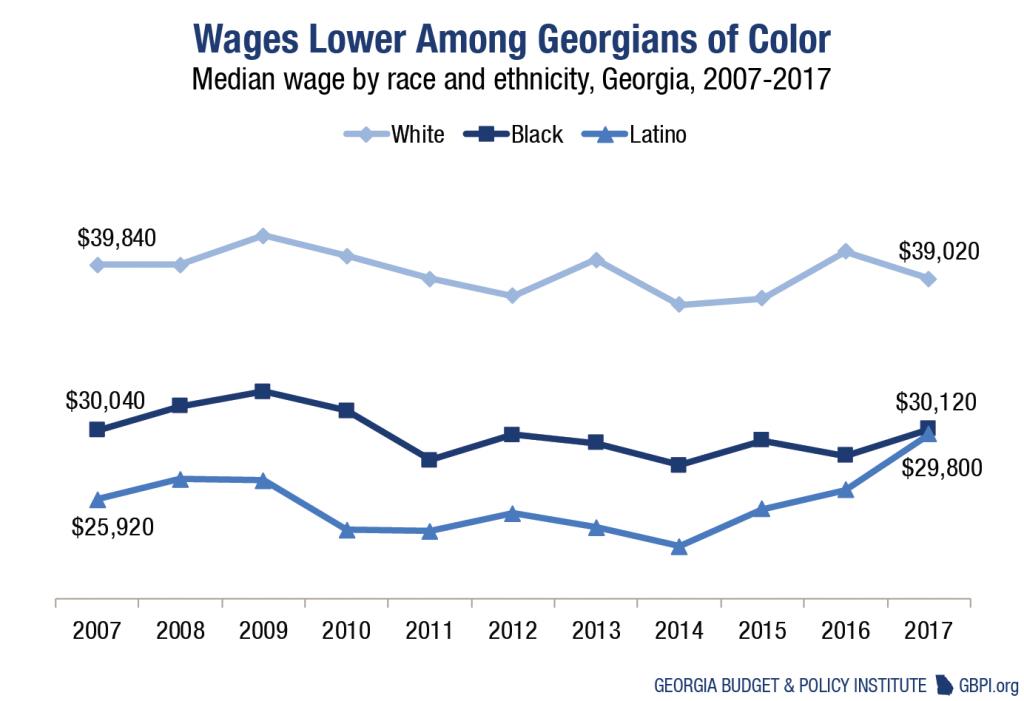
Paychecks for both white and black workers in Georgia are essentially unchanged over the past decade, which can make it difficult for families to keep up with the naturally rising costs of basic goods and services. Latinos, meanwhile, enjoyed an increase in the wage for a typical worker from 2007 to 2017. Still, median wages for both black and Latino workers in Georgia remain well below their white counterparts. A typical black worker in Georgia earned about 77 cents on the dollar compared to a typical white Georgian in 2017, while Latino workers earned about 76 cents on the dollar.
For some people, holding down a job isn’t even enough to fend off poverty. The share of workers earning near-poverty wages declined over the past three decades, but race remains a factor in the share of workers being paid a livable wage.
Workers of color are far more likely to be paid poverty wages than white workers. In 2015, 19 percent of non-white workers worked full time and still lived below 200 percent of the federal poverty line. In contrast, 8 percent of white workers were in jobs that failed to pay enough to support their family by that measure.[21]
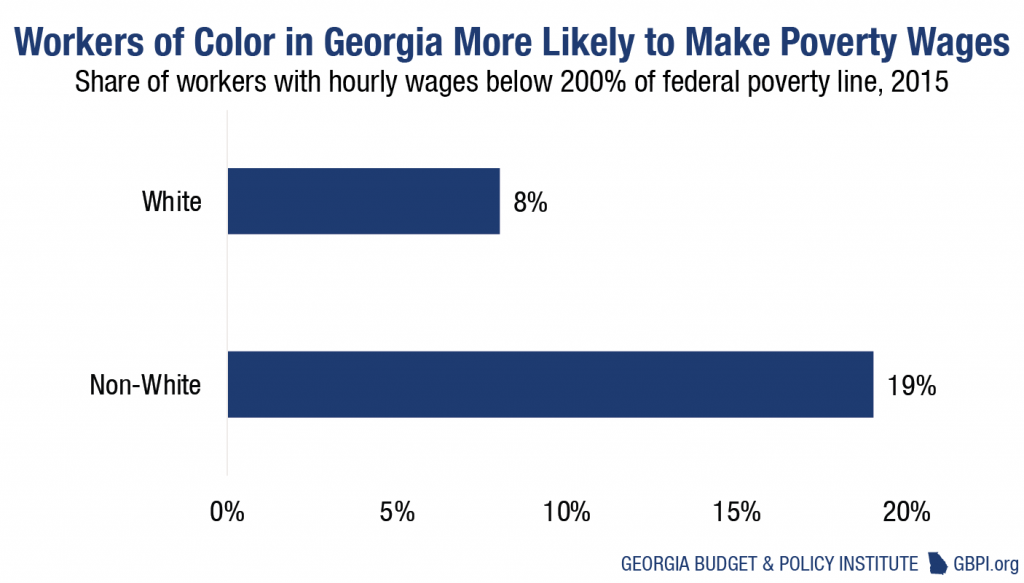
Poverty Disproportionately High for Communities of Color
With stubborn income, wage and employment disparities, it’s no surprise that Georgians of color deal with an above average share of people in poverty. Entrenched poverty holds back economic growth by weakening the productivity and spending power of adults and undermining children’s ability to reach their full potential.
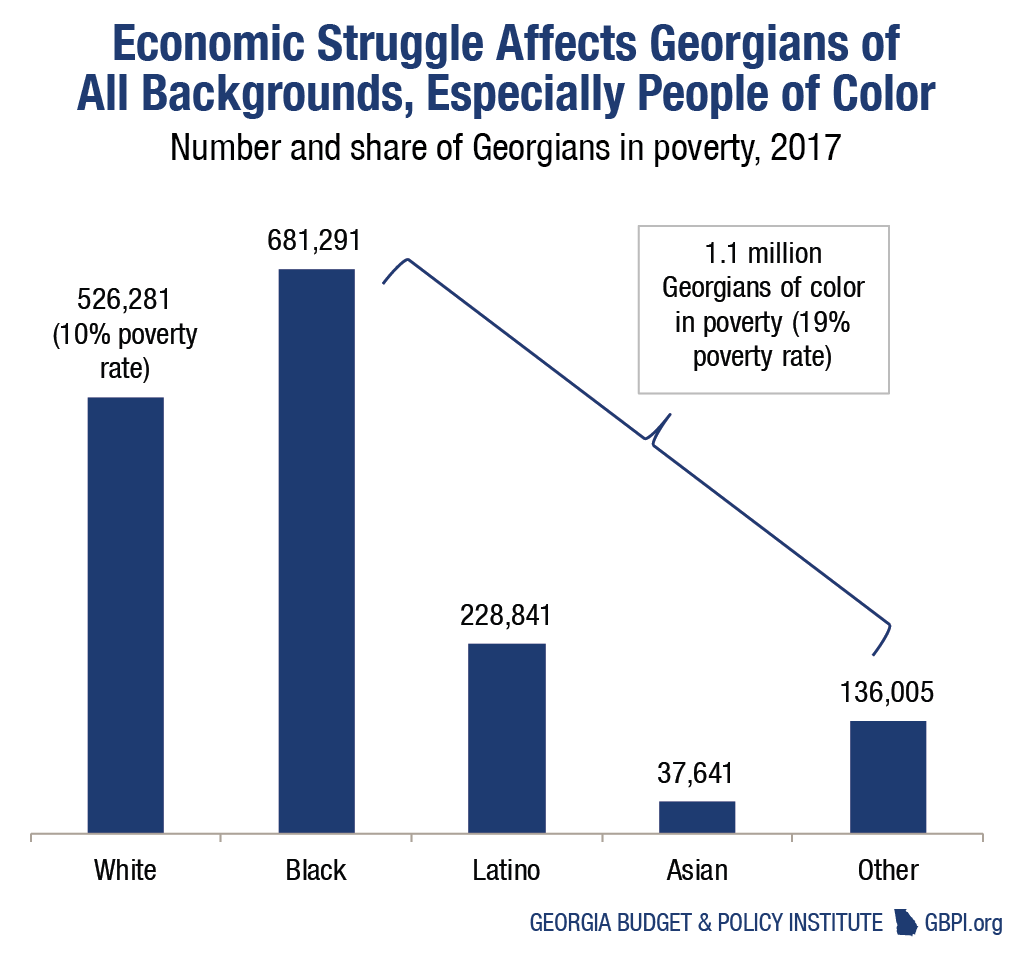
About 15 percent of all Georgians in 2017 struggled to pay for life’s basics, as measured by people who live below the federal poverty line.[22] That’s less than $12,060 for an individual or $24,600 for a family of four. But while poverty’s corrosive effect touches all Georgians, African-Americans and Latinos are over-represented due to historic and current injustices. In 2017, 23.4 percent of Latinos and 21.5 percent of African-Americans in Georgia lived in poverty, compared to 10 percent of white Georgians and 9 percent of Asians.[23] Nearly 1.1 million Georgians of color lived in poverty in 2017, alongside about 526,300 similarly situated white Georgians.
Understanding History Will Help Chart a More Inclusive Georgia
To build a more prosperous Georgia and better leverage the state’s growing diversity, people of all backgrounds need to know the state’s past and present. Georgia made commendable progress over the last century correcting some of the ills caused by a sordid history of racism. Georgia’s history is littered with examples of laws and social systems used to exclude people of color from prosperity. Throughout U.S. history, public policy was used to exclude people of color and perpetuate a racial divide that still continues to hinder the state’s potential.

Under Jim Crow laws, Georgians of color suffered from a system of discrimination that diminished nearly every aspect of their lives. Federal, state and local policies restricted voting access, allowed legal racial discrimination in the housing and employment markets and blocked physical access to public amenities. These policies stubbornly held well into the second half of the 20th century. Only then did court rulings and political reforms end legal discrimination under pressure from a Civil Rights movement that changed the trajectory of Georgia, the South and the country.
While more people of color now participate in the mainstream economy, past and current policies continue to stifle progress in Georgia and reinforce residential segregation. Overt acts of racism are no longer enshrined in law, but structural racism reinforced by residential segregation still inflicts damage. A community’s geography and racial makeup provide a strong indication of the chances for its residents to be successful, so segregation can limit a family’s proximity to economic opportunity.
Segregation carries significant costs, according to a 2017 Urban Institute study. High levels of racial segregation are associated with lower incomes for black families, and lower levels of educational attainment among both white and black families. People living in segregated neighborhoods often get fewer educational and employment opportunities and enjoy less economic mobility.[24] A handful of Georgia counties are still highly racially segregated today, according to county-level tracking by the Robert Wood Johnson Foundation.[25]
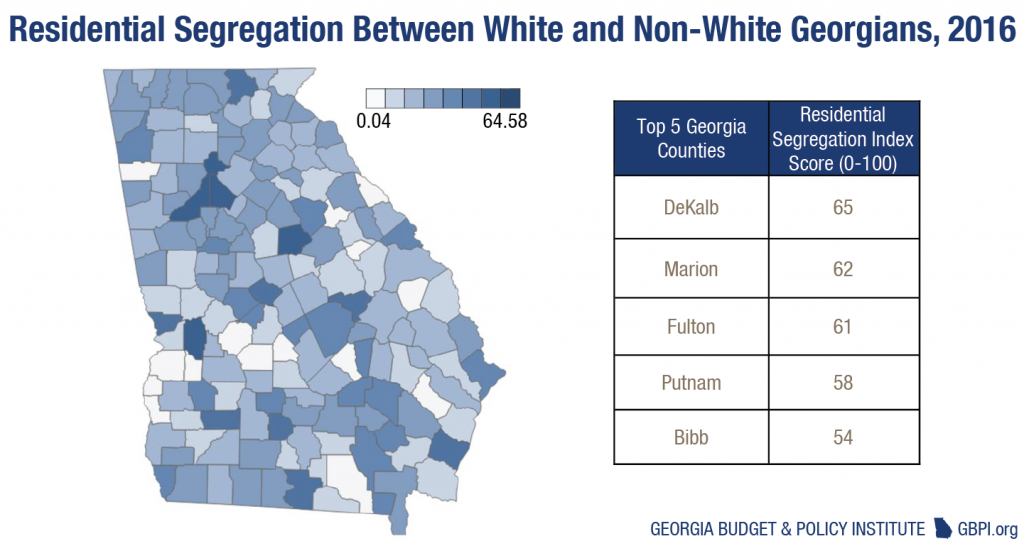
The generational effects of these policies persist, despite the prohibition of overt discrimination. By almost any measure researchers use to determine a person’s potential to achieve economic security and the American dream, people of color are separated by a wide gulf. That holds true for quality-of-life essentials such as employment, earnings, educational attainment and housing. The fallout is evident in the troubling racial wealth divide. Even with equal educational credentials, people of color hold significantly less wealth than white people. Nationwide, a household headed by a white person with a high school diploma holds about twice as much wealth as a household headed by a black or Latino person with a four-year college degree.
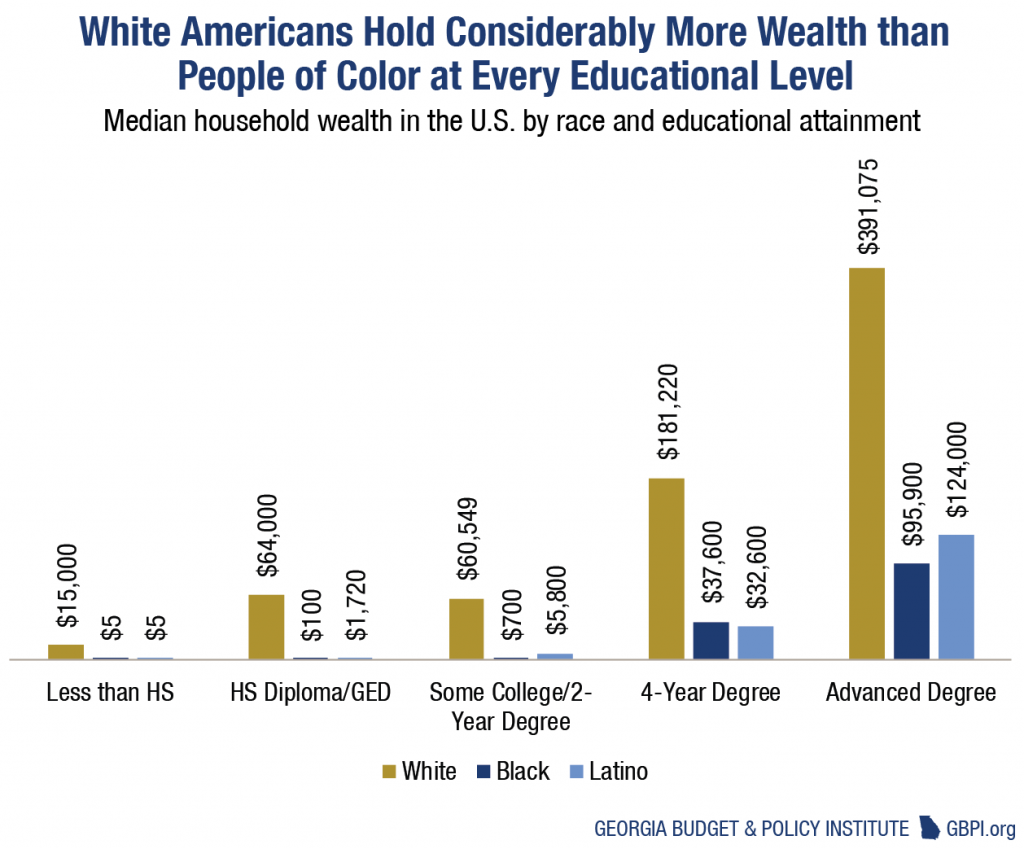
More Recent Policies Present Unique Obstacles to Immigrants
Policies and practices dating back generations imposed hardships on African-Americans in particular. But as larger numbers of Latinos, Asians and multiracial people called Georgia home in recent decades, lawmakers also adopted regressive policies aimed at the state’s immigrant population. That layers on more social and economic harm.
Georgia lawmakers put up steep obstacles to undocumented students who want to attend college, for example.[26] Georgia “Dreamers” brought to the U.S. as children are ineligible for state financial aid and fully barred from some top public universities, an unusual policy approach compared to other states.[27] Georgia is also one of only two states that blocks undocumented immigrants from adult education programs such as a GED® and English language training.[28] This is most counterproductive since more than 300,000 members of Georgia’s adult workforce say they lack English proficiency. That includes 55,000 Georgians who completed college abroad and struggle to speak fluent English.[29]
Georgia’s brand of immigration enforcement is harsher than most, on both the state and local level. State lawmakers adopted one of strictest immigration laws in the country in 2011, which made it difficult for many immigrants to work or contribute to their local communities. Efforts by some state lawmakers to create branded identification cards and deny driver’s licenses to residents with lawful status fell short, but sent a sharp message to new arrivals that Georgia wants to pull up the welcome mat. Some of Georgia’s local governments voluntarily adopt a hand-in-glove relationship with federal Immigration and Customs Enforcement, which disrupts families, creates a culture of fear and harms children in ways that last for life.[30]
“When social and economic barriers for women, people of color and immigrants are dismantled, everyone can enjoy the promise of an equitable and prosperous future.”
– GBPI, People-Powered Prosperity, 2017
Inclusive Policies are Good for Economic Growth
People of color and immigrants are growing at a faster pace than the rest of Georgia’s population, a reality that requires they get an equal chance to participate in the economy. Rampant racial and economic inequality is bad for families and counterproductive to economic growth.
Georgia’s economy could be an estimated $94 billion larger if racial income disparities were eliminated and there was enough work to go around, according to a 2015 study by one prominent think tank.[31] Racial inclusion, openness to immigrants and low levels of income stratification are closely associated with economic health, according to a Federal Reserve Bank of Cleveland analysis of differences in growth among 118 U.S. regions.[32]
Recommendations
Focusing on policies that welcome people from diverse backgrounds into the economy, provide them tools to succeed and eliminate racial and ethnic disparities in income, employment and education are essential to a strong and thriving Georgia future. While no single set of state policies can offer a silver bullet, some core thematic goals can help point the way to a more prosperous and equitable future for all Georgians.
Strengthen family finances, especially in communities of color.
In an era of rising income inequality and persistent racial and ethnic gaps, policies aimed at raising incomes are critical for working families of all backgrounds. But it also makes sense to provide a targeted boost to people of color. For example, raising Georgia’s minimum wage to $10 per hour over three years could give a raise to an estimated 634,000 people of color, as well as 367,000 white Georgians.[33] Enacting a state earned income tax credit, or Georgia Work Credit, promises to deliver a targeted tax benefit of up to a few hundred dollars each year to an estimated 664,000 families of color and 439,000 white families.[34] And, expanding Georgia’s Medicaid program can offer affordable coverage to an estimated 268,400 people of color, alongside 250,200 white Georgians.[35]
Ensure that all Georgians have access to quality public schools and an affordable path to higher education. Policies that support quality K-12 schools and affordable college options can offer people lifelong educational opportunities that help minimize workforce shortages and empower Georgians to transform their lives, improve their earnings and career opportunities and contribute more to their communities and the economy. Georgians of color, historically locked out of a quality public education, still suffer from persistent disparities in education.
K-12 public schools where the majority of students are from low-income families are also the schools with the most black and Latino students. Black and Latino students already make up the majority of the student body in many of Georgia’s school systems. In Chatham County, for example, the two groups are 64 percent of the student population.[36] Schools with large concentrations of students of color often lack the sufficient investments needed to put students on the path to economic opportunity.
In higher education, only 22 percent and 32 percent of Latino and black adults have an associate’s degree or higher, compared to 44 percent of white adults.[37] And only about 20 percent of black students and 36 percent of Latino students in Georgia’s university system receive the HOPE or Zell Miller Scholarships, compared to 45 percent of white students.[38] Opening the doors of college to more students of color will help the state reach its graduation goals and develop the skilled workforce that will provide the lifeblood for Georgia’s growing economy.
Dismantle policies that hinder people of color and immigrants.
The generational legacy of slavery and Jim Crow contributes to policies that continue to stand in the way of non-white Georgians. People of color are more likely to have criminal records for minor or nonviolent infractions due to ongoing disparities in the U.S. justice system. That creates an unfair impediment to getting a job. And African-Americans more often face challenges finding quality affordable housing, due to ongoing patterns of economic segregation in many communities.
Georgia’s immigrant families live in a constant state fear from aggressive local immigration enforcement, an approach that is costly to taxpayers and can impose lifelong harm on young children. And, Georgia is one of three states that bars undocumented students with temporary lawful status from enrolling in some state colleges, even lifelong Georgians. These are only two examples of the type of counterproductive policies state and local lawmakers can more closely review in an effort to ensure all Georgians are treated fairly and equally.
Conclusion: Inclusive Policies are Crucial to Georgia’s Future
As Georgia’s population becomes one of the most diverse in the South, a more inclusive approach that boosts incomes, expands educational opportunities and promotes thriving, equitable communities can underwrite a more prosperous future for everyone. Racial inequities and policies that make immigrants feel unwelcome put Georgia’s current economy at risk and weaken the state’s long-term potential. A better way is to ensure people of every background can access opportunity. That is both the smart and right economic growth strategy for Georgia.
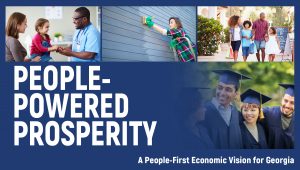 This report is part of an ongoing series of work tied to GBPI’s People-Powered Prosperity initiative, a comprehensive vision for how Georgia lawmakers can bolster support for education, health, child care and other investments that help all Georgians thrive. A statewide poll conducted earlier this year showed nearly two-in-three Georgians support enacting a state Earned Income Tax Credit. Learn more at gbpi.org/peoplefirst.
This report is part of an ongoing series of work tied to GBPI’s People-Powered Prosperity initiative, a comprehensive vision for how Georgia lawmakers can bolster support for education, health, child care and other investments that help all Georgians thrive. A statewide poll conducted earlier this year showed nearly two-in-three Georgians support enacting a state Earned Income Tax Credit. Learn more at gbpi.org/peoplefirst.
Endnotes
[1] GBPI analysis of 2017 American Community Survey 1-year estimates and 1990 U.S. Census.
[2] “Georgia Data Summary,” Policy National Equity Atlas, 2015.
[3] “Population Distribution by Race/Ethnicity,” Henry J. Kaiser Family Foundation. Access September 2018.
[4] Population projections for the 50 states plus D.C. University of Virginia Weldon Cooper Center for Public Service. Accessed September 2018.
[5] “Population Projections,” Georgia Office of Planning and Budget. Accessed August 2018.
[6] To generate these estimates, GBPI combined Georgia’s official state population projections for 2013-2050 generated by the Governor’s Office of Planning and Budget with long-term demographic forecasts for Georgia provided by PolicyLink, a California-based think tank focused on the importance of race equity to the nation’s economy and well-being.
[7] “Historical Census Statistics On Population Totals by Race, 1790 To 1990, and by Hispanic Origin, 1970 To 1990, for the United States, Regions, Divisions, And States,” U.S. Census Bureau. 2002.
[8] 2017 American Community Survey 1-year estimates.
[9] GBPI analysis of American Community Survey 2017 1-year estimates and 1990 U.S. Census.
[10] “Immigrants Make Georgia Stronger and Better Every Day,” GPBI. February 2018.
[11] “Welcome Newcomers to Build a Stronger Georgia,” GBPI. December 2015.
[12] To generate these estimates, GBPI combined data from the U.S. Census Population Projections for 2020-2060 with the Migration Policy Institute’s tabulation of U.S. Census and American Community Survey data from 1990 and 2016. The projections for Georgia’s immigrant share of the population in 2020 and 2050 are generated by assuming that the state will account for the same share of national immigration growth from 2016 to 2050 as it did from 1990 to 2016—3.6 percent.
[13] GBPI analysis of Federal Reserve Bank of St. Louis state-level economic data, 2018
[14] “Is American criminal justice color-blind? The statistics say no,” Urban Institute. 2013.
[15] “Voluntary Immigration Enforcement a Costly Choice for Georgia Communities,” GBPI. July 2018.
[16] “Why Data Disaggregation Matters for Asian-Americans,” Brown Political Review. March 2018.
[17] Economic Policy Institute analysis of Current Population Survey
[18] “Hiring Discrimination Against Black Americans Hasn’t Declined in 25 Years,” Harvard Business Review, October 2017
[19] State-level data on job changes by wage level since the Great Recession provided by the Economic Policy Institute. From 2013 to 2018, the majority of jobs added pay and average hourly wage between $11.00-$14.00 per hour.
[20] “People of Color Will be a Majority of the American Working Class in 2032,” Economic Policy Institute, June, 2016 June 2017
[21] PolicyLink’s National Equity Atlas analysis
[22] GBPI analysis of American Community Survey 2017 1-year estimates.
[23] Ibid.
[24] “The Cost of Segregation: Population and Household Projections in the Chicago Commuting Zone and Implications for Economic and Racial Segregation, 2015–30,” Urban Institute, April 2018.
[25] “County Health Rankings and Roadmaps for Georgia,” Robert Wood Johnson Foundation, 2018
[26] “Georgia’s Higher Education Goals Hurt by Undocumented Student Policies,” GBPI. October 2017.
[27] “Georgia’s Workforce Development, Economy Damaged by Barriers to Higher Education for Undocumented Students.” 2015.
[28] “Education Reform in a Changing Georgia,” Migration Policy Institute. March 2014. Page 13.
[29] “Support Adult English Language Education to Invest in Future,” GBPI. May 2017.
[30] “Voluntary Immigration Enforcement a Costly Choice for Georgia Communities,” GBPI. July 2018.
[31] PolicyLink
[32] “Dashboard Indicators for the Northeast Ohio Economy: Prepared for the Fund for Our Economic Future,” Federal Reserve Bank of Cleveland, April 2006
[33] An estimated 32 percent of Latino workers, 31 percent of black workers and 24 percent of Asian workers would see a raise under the policy, along with 16 percent of white workers. Estimates provided to GBPI on request by the Economic Policy Institute, 2017.
[34] Looking at Georgia’s communities of color specifically, an estimated 36 percent of black families, 28 percent of Latino families, 19 percent of Asian families and 20 percent of other families could benefit. For more details see “A Bottom-Up Tax Cut to Build Georgia’s Middle Class: 2018 Update,” GBPI. October 2018.
[35] GBPI analysis of the 2016 American Community Survey
[36] GBPI analysis of Governor’s Office of Student Achievement school-district enrollment data, 2016-2017
[37] “Troubling Gaps in HOPE Point to Need-Based Aid Solutions,” GBPI. September 2016.
[38] Ibid.









